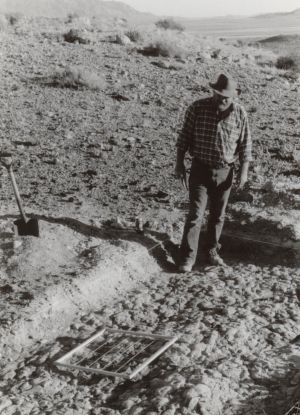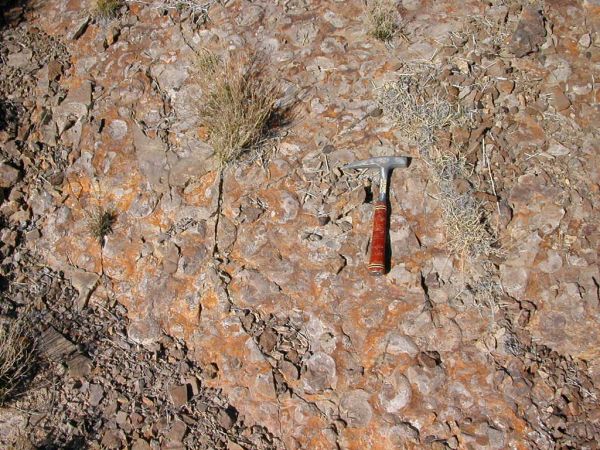A
5.25 square meter area on top of the Anasibirites Bed in the Triassic
Thaynes Formation of West Central Utah was uncovered, photographed,
and
mapped. Just the cephalopods that were fully exposed, and
complete
enough for orientation determination were mapped. The area was
excavated
and photographed in October, 1997. It was collected by me in
September,
1998, and by others, both known, and unknown, since. A small
outcrop
about 200m north of the mapped area provided samples for the cross
section,
the two units are easily correlated with the 20-50mm shale bed below
the
top section.

The
top
of
the Anasibirites Bed during mapping
- Semelparous activity
(like spawning Salmon)
- Toxic environment
(anoxia etc.)
- Condensed (low sediment
deposition over time)
- Washed in
The graphs
on
the stats page, come from the map, and show mostly information
pertaining
to the composition of the fauna and prefered orientation of the
shells.
The cross section gives information on the faunal composition
and
thickness of the strata.
Faunas
Studies
that have been done trying to answer all the questions. No end
in sight?
Brayard,
A., Bylund, K. G., Jenks, J., Stephen, D. A., Olivier, N.,
Escarguel, G., Fara, E. & Vennin, E., 2013.
Smithian ammonoid faunas from Utah: implications for Early Triassic
biostratigraphy, correlations and basinal paleogeography. Swiss
Journal of Paleontology 132:141-219.
Daniel
A. Stephen, Kevin G. Bylund, Paul J. Bybee and Wesley J. Ream,
2010, Ammonoid Beds in the Lower Triassic Thaynes Formation
of western Utah, USA, in: Cephalopods – Present and Past, edited by
K. Tanabe, Y. Shigeta and T. Sasaki & H. Hirano. Tokai
UniversityPress,
Tokyo, p. 243-252

